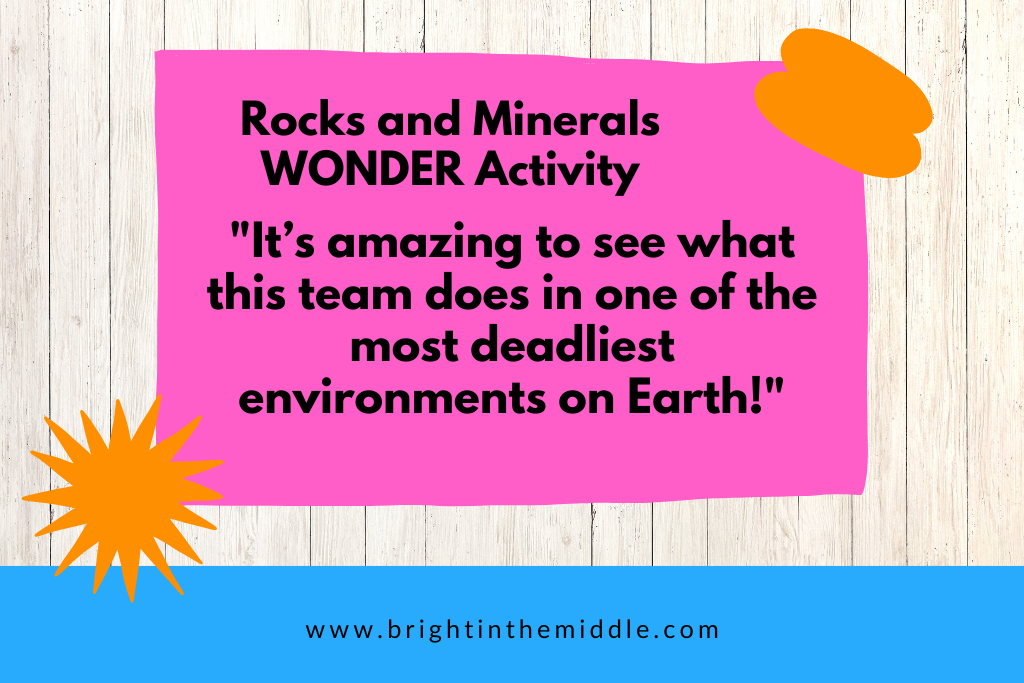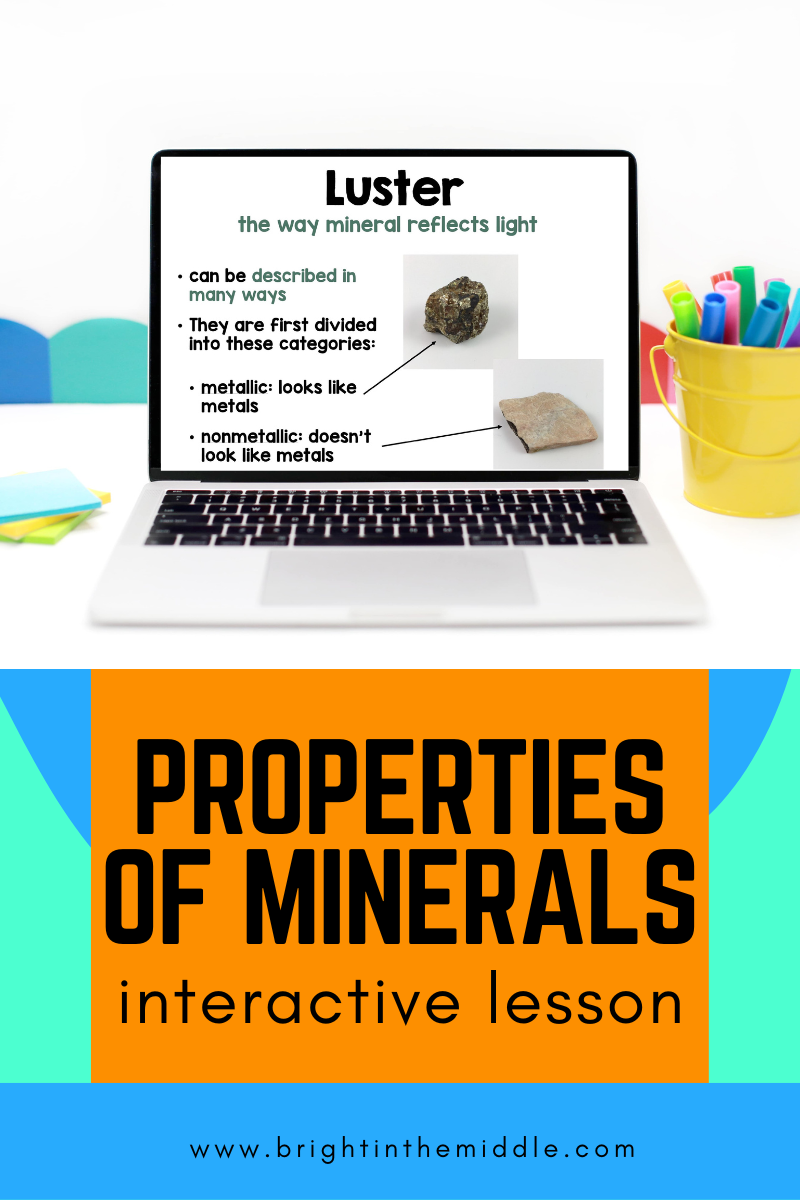Starting your rocks and minerals unit and already checking out those worksheets on rocks and minerals? Well, I say let’s set those over to the side and look at some WOW factor ideas. So, I will start off by stating, if you are looking for something deeper into the unit, like the rock cycle, this isn’t the post for you, but no fear, I do have a post for that! This post includes ideas for when you are FIRST starting to teach about rocks and minerals. This is the lesson that you begin with by discussing the properties of minerals and how rocks are made of one of more of these different minerals. Some rocks are even made of NO minerals at all, such as coal.
In this post, I will discuss ways to start out your lesson to get students so hyped up about learning more about this topic and start their journey on asking a million rocks and minerals questions. Then, I will share a lesson on the properties of minerals that will help reduce the overwhelm of learning all of the material. Finally, I will share some ideas on how you can widen their knowledge before moving on.

Introducing Rocks and Minerals
I’ll be honest, rocks and minerals have not always been my favorite topic. It’s growing on me though! Why? Well, because of engaging activities like the ones I’ve listed below. Doing a WONDER strategy before teaching a lesson is a way to get your students hype about learning a topic!
Look at Rocks and Minerals
How are rocks and minerals different? Where can you find rocks and minerals? What better way to answer these questions and actually define rocks and minerals than to explore them! There are probably rocks and minerals around your students all of the time, but they may not know what they are. Also, there are a ton a rocks and minerals that your students have never been exposed to.
This is your chance to introduce them to something new. There are a lot of kits out on the internet, and you may even have some already at your school!
You can show these items to your students. You can have them to observe and explore. You can even have your students to sort them into categories as they wish.
You can even give them guiding questions. Here are some examples:
- Do notice any differences between the minerals and the rocks?
- How are rocks and minerals related?
- What features do you notice?
- Are there any features that are distinguishable?
- What do you think? How are rocks and minerals formed?
Your students may or may not know the answer to some of these questions, but at least you got them thinking. They may also be excited. How cool is the shine in pyrite? Wow, sulfur stinks! Obsidian is so smooth. What else might your students notice?
Naica – Crystal Cave Documentary
I love this because students get exposure to some STEM careers while learning about rocks and minerals in real life situations. You can find this documentary in different locations, but the best place I’ve been able to find it online is through Amazon.
This is a 2008 documentary where a group of international scientists explore a cave in Mexico with giant crystals. It’s amazing to see what this team does in one of the most deadliest environments on Earth!
This team explores this cave, which is known for some of the largest crystals in the world. Some are over 30 feet long and weigh over 55 tons! These scientists also want to learn more about the unique microorganisms that live in these extreme conditions!
There is so much beauty in this cave. Your students will be interested! It would also be interesting to find out if any of your students would be willing to have that sort of job. I will tell you, it sure isn’t for me!

Explore Awesome Buildings
Along the lines of the beauty in the cave, humans have created beauty using rocks and minerals in some amazing buildings!
You can either show pictures or videos of these buildings. Ask your students what building materials were used to create the amazing structures. You can have a great discussion. How do we benefit from rocks and minerals? Why are rocks and minerals so important? Well, there are many reasons, but using them for construction is one of those reasons!
Here are some examples of buildings you can discuss:
- The Great Pyramid of Giza, Egypt: made of limestone blocks
- The Taj Mahal, India: made of white marble
- Petra, Jordan: carved into sandstone cliffs
- Machu Picchu, Peru: made using granite blocks
- St. Peter’s Basilica, Vatican City: made of marble, brick covered with lead
- The Great Wall of China: made of a variety of materials including brick, tamped earth, and stone
Want to engage students more? Have them to explore these buildings and structures in Google Earth! There are so many different aspects of these structures that students can see on Google Earth that they cannot explore in a picture.
Only have time for pictures? Another fun way to do this activity is to print pictures of these structures and place them all around the room. Have students to observe this way and answer the guiding questions!
Skip the Worksheets on Rocks and Minerals with this Dynamic Duo
What dynamic duo am I speaking of? Well it’s an interactive lesson of course! Interactive lessons include both the lesson material with embedded activities inside the lesson to better chunk information into digestible pieces.
These interactive lessons help to reduce student cognitive load. Oh, and they are fun!
The lesson I would start out the unit with is learning about the properties of minerals. Before you can understand what a rock is, you must understand the minerals that make up the rocks.

In this lesson, students will learn all about the 5 characteristics of minerals and the properties of minerals including color, streak, luster, cleavage and fracture, hardness, and specific gravity. They will also be briefly introduced to transparency, translucency, opaqueness, taste, tenacity, acid reaction, magnetism, and crystal shape. That may seem like a lot, but this lesson is specifically designed to overcome the overwhelm of the information!
Interactive activities are embedded throughout and these include a KWL, four corners vocabulary, drag-and-drop activities, exploring outside resources, and more! This takes you beyond a regular worksheet on minerals!
This lesson can be found in the Bright in the Middle shop.
You can also find this on TPT.
Want to learn more about rocks and the rock cycle? Want to skip those worksheets on types of rocks? I got you! I’d recommend doing this lesson right after your minerals lesson so that students can easily make connections!
How to Study Rocks and Minerals – Widen Their Knowledge
Now that students have been introduced to minerals and know a little bit about rocks, it’s time to widen their knowledge. Here are some activities that you can do!
Make Rock Crystals
The size of crystals is dependent on the environment they are formed.
So, how can you form crystals in your classroom? Have your students create Epsom salt crystals! You can have them to create them under different conditions such as low cooling over hot water, rapid cooling over ice water, and a control over room temp water.
Showing is better than telling. Watch this video and do what you think is best for your classroom!
Some of the materials you will need include Epsom salt, food coloring, hot water, and a beaker. If you want to try this under different conditions, you’ll need ice water as well.

Research Birthstones
Another fun way to widen their knowledge is to have them study their own birthstone! They will be so excited to learn about their personal birthstone while being reminded of the properties of minerals. They can create a poster, slideshow, brochure, or anything from their research!
Here are the birthstones for each month:
January – Garnet
February – Amethyst
March – Aquamarine, Bloodstone
April – Diamond
May – Emerald
June – Pearl, Alexandrite, Moonstone
July – Ruby
August – Peridot, Spinel, Sardonyx
September – Sapphire
October – Opal, Tourmaline
November – Topaz, Citrine
December – Turquoise, Zircon, Tanzanite
I don’t have a resource I’ve created myself, but feel free to create your own, or explore this one created by Science Is Booming!
Jump into the Rock Cycle
Tired of minerals yet? Me neither! They are awesome, but you do have to move on with your content sooner or later. Once your students have had this introduction, you can go ahead and dive in deeper with rocks and the rock cycle. They will also learn more about how rocks and minerals are different.
Learning about the rock cycle can be just as fun. They’ve already had a chance, if you chose this wonder strategy, to look at rocks. Now it’s time to explore just where they came from and how they change throughout their cycle.
Your students will love these WOW Factor Ideas. Enjoy!
Help your students master science content!



[…] Minerals and Rocks […]